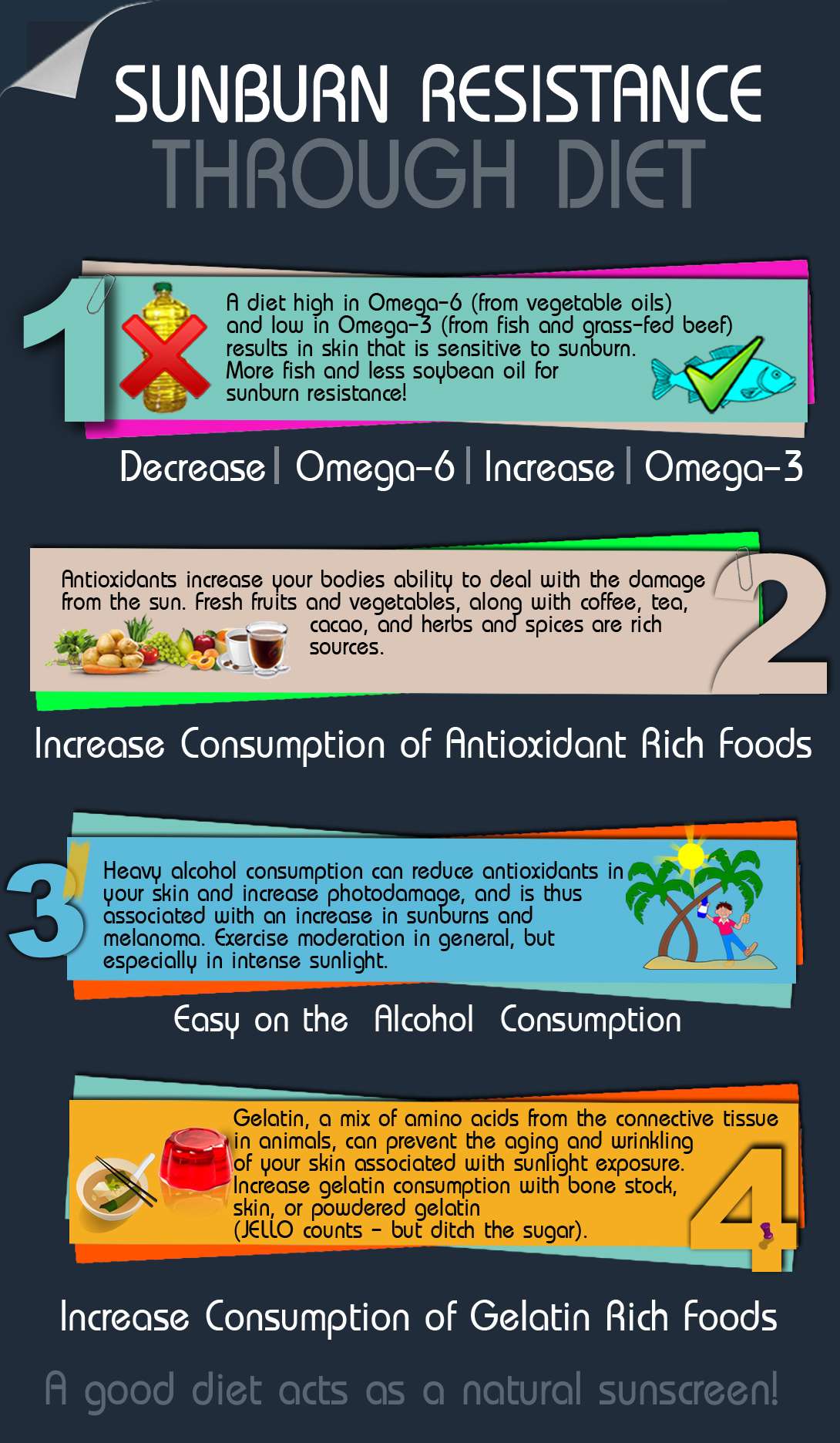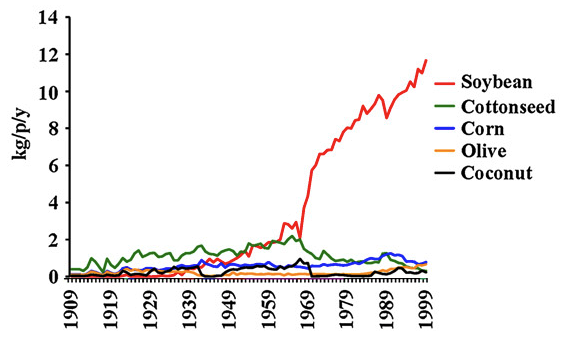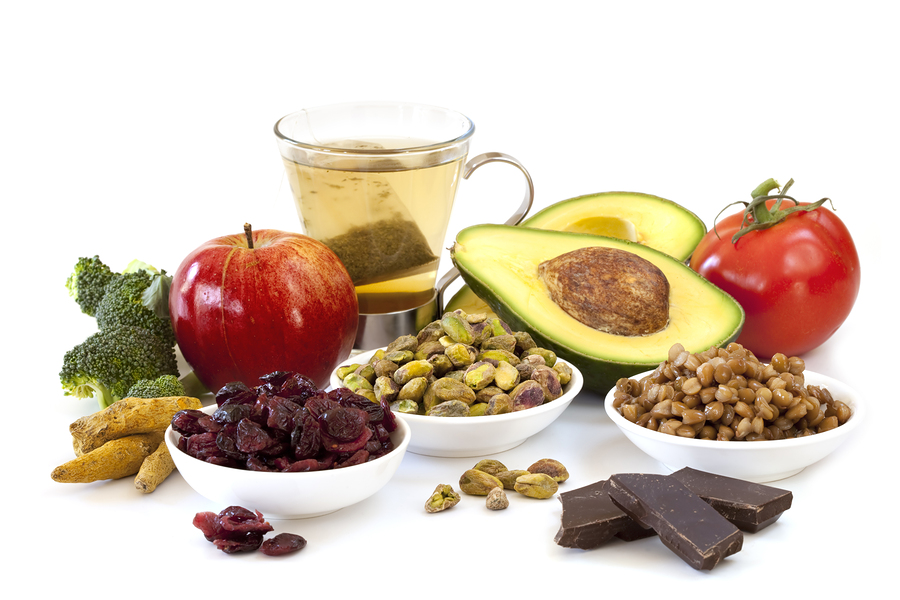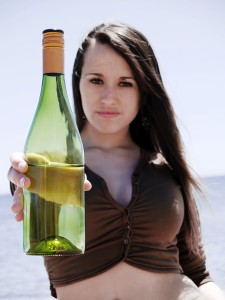This article is courtesy of sustainablebalance.ca






SUNLIGHT SERIES – PART 10: SUNBURN RESISTANCE THROUGH DIET
Introduction:
Previously in this series, the benefits of sunlight in the form ofvitamin D production were discussed along with the ramifications of vitamin D deficiency. Along with vitamin D deficiency, another crucial benefit of sunlight (control of circadian rhythms) has been introduced. To top it all off, here’s another: sunlight on human skin increases nitric oxide in the bloodstream, which is important in regulating blood pressure and reducing risk of heart attack and stroke. Sunlight is essential to health.
The last post also introduced how UV-B radiation, which produces vitamin D, also leads to sunburn which many people believe leads to skin cancer. Three types of skin cancer and their accompanying statistics were reviewed, where it was posited that greater than 99% of all skin cancer cases are not fatal. 75% of melanoma cases, the most fatal of the three types of skin cancer, were shown to be present on parts of the body that are relatively unexposed to UV-B radiation(trunk and thighs as opposed to face and hands). Also, it was shown that melanoma rates have been increasing at an alarming rate over the past 30+ years, while UV radiation exposure rates have, on average, decreased for inhabitants of developed countries. The case was made that UV radiation alone cannot explain the massive increase in skin cancer. Something else must be at play.
It is illogical that a natural source of life-giving radiation (the sun), that we as human animals have been exposed to since the dawn of our species is now most commonly implicated as the source of a disease (skin cancer) that has only recently become proportionally common, while exposure to this radiation source has, on average, been decreasing.
The case has already been made that the sun’s radiation has not significantly changed, and yet we do see skin cancer rates increasing in developed countries. UV radiation has a role in the development of skin cancer, in that it does damage skin cells, but UV radiation has not changed. What has changed is the resistance of our skin to UV radiation.Skin that is the least prepared to receive the critically-important-for-health UV radiation will have the greatest risk of being sunburned, and have a greater risk of developing skin cancer.
As always, with anything health related, there is a context to healthy sunlight exposure. Sun exposure only becomes dangerous when intense sunburns become too easy. As mentioned in the previous post, after receiving a dose of UV radiation, some amount of damage incurs, and skin then produces melanin (read: a tan), which then protects the skin from further damage from UV radiation. Darker-skinned individuals already have high levels of melanin (known as constitutive pigmention), and thus are much less likely to burn to begin with. Thus, forming a tan is one way of preventing damage from UV radiation. Some individuals may be thinking “Well, I don’t tan, so there’s nothing I can do about it”, and there may be truth to that in extreme cases. However, most people can improve their ability to tan, and increase their resistance to the sun in general, with improved dietary practices and sun exposure behaviours.
This post will explore the combination of sun exposure, sunburn resistance and dietary habits that result in the benefits of sunlight exposure, while significantly reducing the dangers.
Sunburn Resistance Through Diet:
It may surprise you that your resistance to sunburn can be influenced by your diet, but from my research and experiences I know this variable is significant. Unfortunately, there is no ‘magic-food’ that will instantly turn your skin into a suit of sun-blocking armour, but there are a few eating habits that can tip the scales in your favour and help you reap the benefits of sunlight exposure without getting fried. As implied in the last sentence, increasing your resistance to sunburn requires improvement in eating habits, so the results will take some time once the changes are made, but will be well worth it in the long run. According to Jean Krutmann and Philippe Humbert, authors of Nutrition for Healthy Skin, making these dietary changes will produce more sunburn-resistant skin in about 8 to 10 weeks.
So, where to begin? To start off, below is an infographic that summarizes everything I’ve found on this subject. Then, for the science enthusiasts, below that are all the nitty gritty details on the subject. Let’s hit it!

Here it is all summed up. Easy enough, right? Being fully immersed in the modern food industry can make this tough! Read on to get more details.
1. Reduce Omega-6 fatty acids, and Increase Omega-3
Fatty acids are the energy carrying portions of fats and oils that our bodies can use for fuel, and also in some cases as a structural component in the membranes of cells throughout the body. When it comes to fatty acids, as you may have noticed from occasionally reading nutrition labels, there are:
- Saturated fatty acids
- Monounsaturated fatty acids
- Polyunsaturated fatty acids
The degree of ‘saturation’ has to do with the chemical qualities of the fatty acid. Essentially, a fatty acid is a carbon-atom chain. So, each carbon is connected to a neighbouring carbon or two, and otherwise is connected to hydrogen (unless it’s at the end of the molecule, and then it is connected to oxygen). Here is an illustration of a saturated fatty acid:

Each middle carbon is connected to two neighbouring carbons, and usually two hydrogens. Note that the two oxygens only occur at the right side. That’s what makes it an acid.
As a quick explanation of the differences (follow up post someday, I swear), saturated fatty acids have all the middle carbons connected to two hydrogens. It is thus saturated with respect to hydrogen. If one of the hydrogens is missing (due to a double bond between the carbons), then it is unsaturated with respect to hydrogen, and we’d call it monounsaturated (mono- meaning one). If there are multiple hydrogens missing (due to multiple double bonds between carbons), we call it polyunsatured (poly- meaning multiple). When it comes to omega-6 and omega-3 (n-6 and n-3), we are talking about polyunsaturated fatty acids. These fatty acids are essential in the diet, meaning we need them to survive, but our bodies can not produce them from other fatty acids. When absorbed by the body and used for various functions, n-6 fatty acids are pro-inflammatory, and n-3 fatty acids are anti-inflammatory. Why does this matter when it comes to sunburn resistance? Sunburns ARE inflammation.
Anthropological research suggests that historically the ratio of n-6 to n-3 in the human diet was 1:1, but nowadays is usually as high as 15:1, and can be even as high as 30:1. N-6 fatty acids are displacing n-3 fatty acids, and our inflammatory responses are spiralling out of control as a result. Sources of n-3 include (from best to worst) fish and seafood, grass-fed meats, and some nuts and seeds (chia and flax contain significant plant-based n-3). Significant sources of n-6 fatty acids include refined vegetable oils that have recently become a much larger part of our diets. Soybean oil, corn oil, canola oil, cottonseed oil, grapeseed oil, and many others are all very high in n-6 fatty acids, and have very little n-3. The oils from almost all nuts and seeds (save macadamia nuts and chia and flax seeds) are all notoriously high in n-6 as well. Even if you don’t use these oils in your home, they are almost ubiquitous in restaurant use (especially fast food joints, including deep fryers). They are also an ingredient in most processed foods (crackers, cookies, etc.), bottled salad dressings, bottled mayonnaise, and margarines. Here is a plot showing the increase in soybean oil consumption during the 20th century:

The vertical axis represents kilograms of oil consumed per person per year of consumption, and the horizontal axis is the year. Adapted fromhttp://ajcn.nutrition.org/content/93/5/950.full.pdf+html
The link between excess n-6 in the diet and cancer is very strong. In general, n-6 is tumour promoting, and n-3 is tumour inhibiting. Truly, what is required is a n-6:n-3 ratio closer to the ancestral norm of 1:1. When it comes to sunburns and skin cancer there is ample evidence that n-3 fatty acids increase the sunburn threshold (amount of exposure to induce a sunburn) and inhibit the formation of skin cancers, and are thus photoprotective (protect against light). Quite literally, n-3 fatty acids allow you to be out in the sun longer without burning and significantly slow the development of skin cancers. Excess N-6 fatty acids, on the other hand, have been shown toincrease photocarcinogenesis (skin cancer as a result of UV-exposure).

The omega-3 fatty acids in these fish can keep inflammation at bay and prevent sunburn so long as you keep your omega-6 intake reasonably low. Credit to Andrea Nguyen for the photo.
Moral of the story: In the modern diet, we eat way too much n-6, and not enough n-3, and this is doing many things, including promoting sunburns and skin cancers. Lower your n-6 intake (vegetable oils), and increase your n-3 intake (fish and grass fed beef), and you will be much more resistant to sunburns and skin cancer!
*As a side note, there isn’t much clinical evidence yet, but there is anecdotal evidence that displacing n-6 fatty acids with saturated fatty acids (mostly from animal fats, but also coconut and palm oils) increases resistance to sunburns as well. In this study, mice fed saturated fat vs. polyunsaturated fat held off melanoma the longest. Eat that coconut oil and butter!
2. Increase Consumption of Antioxidant-Rich Foods:
OK, now that we’ve ditched the soybean oil and are eating fish with abandon, what else can we do? Well, once UV radiation hits your skin, it pulls off electrons and breaks molecular bonds through oxidationand creates free radicals. These free radicals are unstable, and go on to wreak havoc on all sorts of molecules in your body, which can lead to the development of cancers, including skin cancers. This is basically where the sun = cancer hypothesis came from. Unfortunately, most sunscreens don’t help in this regard.
Luckily, there are natural chemicals in plant and animal foods called antioxidants that mop up these free-radicals before they can cause any damage.These chemicals are produced by plants to protect themselves from UV-damage and other threats. Animals (humans included) can consume these antioxidants, and either use them directly, or use them to stimulate the production their own animal versions of antioxidants that do the same thing (endogenous antioxidants – made in the body). Before looking at these individual antioxidants, it should be made clear that getting these antioxidants from whole foods is vastly superior to taking supplements. These compounds work synergistically (in combination), sospecific antioxidant supplements don’t really work, while consuming whole fruits and vegetables does work. Get your antioxidants from whole foods.
Examples of these antioxidants:
There are more than what is included in this list, but the following have the most clinical evidence.
Vitamin E: This fat-soluble vitamin comes in eight different forms and has been shown to increase human photoprotection. Beware though, the form of vitamin E in canola oil, soybean oil, and corn oil contributes to lung inflammation and asthma (need any more reasons to ditch these oils?). Get your vitamin E from free-range egg yolks, olive oil, avocado, and moderate amounts of sunflower seeds and nuts.
Vitamin C: Also known as ascorbic acid, famous for helping to fight the common cold, is also photoprotective. Vitamin C is best used in combination with other antioxidants for this particular purpose. Vitamin C is readily available in almost all vegetables and fruits.
Vitamin(s) B: There are eight distinct vitamins that are all “B vitamins”. Many of them play a role in human skin photoprotection in combination with other antioxidants. Specifically, a form of niacin (vitamin B3) is particularly photoprotective. These vitamins are obtained from veggies, fruits, and animals. Vitamin B12 has no plant source, so animal foods (meat, dairy, eggs) are necessary for this particular B vitamin (supplementation is available for vegans).
Carotenoids: This category includes several antioxidants like lycopene, beta-carotene, and astaxanthin, which are all strong antioxidants that display powerful photoprotective effects in humans after consumption. Lycopene is found in abundance in tomatoes. Beta-carotene is found in sweet potatoes, carrots, and dark leafy green vegetables (amongst others). Astanxanthin, which is a little more rare, is found in salmon and shrimp, although marine algae is also a good source if you can get it (I’d prefer the salmon, thanks). Carotenoids combined with sufficient selenium in the diet offers even greater UV protection.
Flavonoids and Polyphenols: These antioxidant categories are found in a myriad of different sources, and many are known to bephotoprotective to humans when consumed. Powerful sources include coffee, cacao, tea (green and black), citrus peel, grape seeds, red wine, herbs and spices, berries of all types and other fantastic and delicious gifts from nature. Drink that coffee (or tea, or wine) before you hit the beach!

Foods rich in antioxidants will clean up the damage incurred from sunlight exposure. Eat up to clean up!
Moral of the story: Even if you incur some UV-damage, with sufficient antioxidants in your system you can reap the rewards of sunlight and clean up the damage, so no stress! Nutritionally empty foods like flour and sugar do not contain these antioxidants, so focus on unprocessed and colourful fruits and veggies along with herbs and spices and coffee/tea/cacao.
3. Easy on the Alcohol Consumption
This suggestion won’t be popular one in some circles. In general, heavy drinking is associated with an increased risk of sunburn andalso of melanoma. Perhaps drinking in the sun is causing people to ignore the signs of overexposure (burning), but another theory is that alcohol consumption inhibits the absorption and utilization of many of the above mentioned photoprotective nutrients. Also, heavy drinkers are known to have poor diets to begin with. Evidence for this theory has recently been published. Researchers measured reduced antioxidant levels in the skin of intoxicated subjects, and smaller amounts of UV-radiation were then required to induce a sunburn. Antioxidant rich orange juice combined with alcohol helped to mitigate this damage, however.
My thoughts are that a little red-wine or a couple beers on top of good food here and there won’t severely impact your photoprotection status (a bit of red-wine might even help, see above), but a habit of heavy drinking in strong sun combined with junk food appears to be unhealthy. Who would have thought?! (Sarcasm intended).
Moral of the story: Easy on the booze in general, but especially when out in the strong sun, and be sure to consume plenty of antioxidant rich food along with it.
4. Increase Consumption of Gelatin Rich Foods
This link is not as strong as the others, but there is evidence that increasing the amount of gelatin in your diet could help stave off photo-aging (here’s another study). Photo-aging is not the same as sunburns, per se, but it is the wearing down and wrinkling of skin due to UV-exposure over long periods of time.
Gelatin is a rendered mix of amino acids (building blocks of proteins) from the connective tissue in animals (ligaments, tendons, skin, bones, hooves, and the like), which collectively can be called collagen. Collagen is also the most abundant protein in the human body, so eating gelatin to support the creation of that collagen makes sense. Consuming gelatin is a rarity these days as the connective tissue of animals is usually overlooked as a food source in modern times (except for our dogs, perhaps). There are a host of benefits the consumption of gelatin, and preventing sun-induced wrinkles is just one of them.
Sources of gelatin include beef/chicken/pork stock (the liquid from boiling bones, can be purchased from good butchers, or made at home), cuts of meat on the bone, animal skins (have skin ON the chicken), animal gristle (you learn to like it), and bone marrow. You could also go for gelatin in powdered form, which when combined with sugar, is good ol’ J-E-L-L-O. I don’t recommend the sugar, by the way. You can get plain powdered gelatin just as easily.

Why not toss a little antioxidant-rich fruit in with the jello as well for a double-whammy? Credit goes to Peter Thoeny for the image.
Conclusion: Eat Well, and Sunburn Resistance is Easier
After reviewing all the research mentioned above, and combining that with my own experiences, I have come to the conclusion that anyone can improve their sunburn resistance naturally by following the suggestions in this post.
Really, it comes down to following what would be a natural diet for humans during the vast majority of our evolution as a species. Only in the past century or so have n-6 fatty acids become such a huge part of our diet (often at the expense of n-3′s). The increased consumption of sugar and other highly-processed nutrient-depleted foods and the displacement of antioxidant-rich fresh fruits and vegetables has decreased our ability to deal with various stressors, UV-radiation included. High alcohol consumption impairs the digestion of some of the critical nutrients to deal with UV-radiation, while consumption of gelatin/collagen used to be commonplace but has become rare at best.
I cannot yet say definitively, but my current thoughts based on my research and experiences are that the changes in human diet, combined with the changes in human behaviour, over the last century are responsible for the majority of the increases in sunburn-sensitive skin, and skin cancers. Eat closer to how our ancestors did and our skin will be stronger! Sounds like another benefit of the primal/paleo eating strategy! Again, these changes take about 8-10 weeks to become noticeable, so start now.

No comments:
Post a Comment